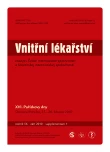Thrombocytopenia in patients with acute promyelocytic leukemia
Authors:
Z. Kořístek
Authors‘ workplace:
Interní hematoonkologická klinika Lékařské fakulty MU a FN Brno, pracoviště Bohunice, přednosta prof. MUDr. Jiří Vorlíček, CSc.
Published in:
Vnitř Lék 2010; 56(Supplementum 1): 43-45
Category:
16th Parizek's Days, Ostrava-Poruba, March 25th –26th 2010
Overview
Fatal bleeding is still the main cause of early death in patients with acute promyelocytic leukemia (APL). The severe bleeding disorder arises from thrombocytopenia and, obviously, from complex coagulopathy typical for APL. The extend of thrombocytopenia is related to the severity of coagulopathy, and this was the reason why thrombocytopenia was considered when the three risk groups (low, intermediate, high risk) for APL were made by Sanz et al. Contrary to leukocyte concentration in time of diagnosis which increases the probability of relapse, thrombocytopenia mirrors more likely the risk of early death. Risk of bleeding is inversely related to the concentration of thrombocytes and, therefore, thrombocytopenia during the first days in APL should be considered in a different way than in other hematological malignancies. Platelet transfusions are the principal treatment of coagulopathy and thrombocytopenia in APL, because despite the progress in diagnostics and complex therapy of APL there is no clear and unambiguous recommendation for treatment of APL coagulopathy using either heparin nor antifibrinolytics or plasma coagulation factors substitution etc. Mistakes often originate from certain misunderstanding of recommendations for transfusion policy in APL, when satisfactory prophylactic treatment means that thrombocyte concentration never decreases under the recommended level (typically 30 – 50 × 109/ l). Analysis of the data from centers which cooperate with CELL (the Czech leukemia study group for life) showed that patients with APL were sending to those centers sooner, and the diagnostics were faster in last four years in the Czech Republic. This fact improved the distribution of patient in the risk groups. Moreover, the early mortality meaningfully decreased, undoubtedly thanks to the more intensive substitution therapy of thrombocytopenia and coagulopathy. Between 1989 and 2006, the distribution of patients diagnosed with APL in the Czech Republic was 33 % high risk, 46 % intermediate risk, and 22 % low risk, and only 69 % of patients reached complete remission after induction therapy. In the last years, between 2006 and 2009, the distribution of patients with APL diagnosed and in CELL cooperating centers changed to 17 % high risk, 45 % intermediate risk, and 38 % low risk, and 93 % of the patients reached complete remission after induction. These newer results are fully comparable with countries, where the results of diagnostics and treatment of APL are the best – and we can conclude, that this is the best message for the Czech hematology.
Key words:
acute promyelocytic leukemia – thrombocytopenia – coagulopathy
Sources
1. Sanz MA, Lo Coco F, Martín G et al. Definition of relapse risk and role of nonanthracycline drugs for consolidation in patients with acute promyelocytic leukemia: a joint study of the PETHEMA and GIMEMA cooperative groups. Blood 2000; 96 : 1247 – 1253.
2. Didisheim P, Trombold JS, Vandervoort RLE et al. Acute promyelocytic leukemia with fibrinogen and factor V deficiencies. Blood 1964; 23 : 717 – 728.
3. Goldberg MA, Ginsburg D, Mayer RJ et al. Is heparin administration necessary during induction chemotherapy for patients with acute promyelocytic leukemia? Blood 1987; 69 : 187 – 191.
4. Rodeghiero F, Avvisati G, Castaman G et al. Early deaths and anti-hemorrhagic treatments in acute promyelocytic leukemia. A GIMEMA retrospective study in 268 consecutive patients. Blood 1990; 75 : 2112 – 2117.
5. Menell JS, Cesarman GM, Jacovina AT et al. Annexin II and bleeding in acute promyelocytic leukemia. N Engl J Med 1999; 340 : 994 – 1004.
6. Kawai Y, Watanabe K, Kizaki M et al. Rapid improvement of coagulopathy by all-trans retinoic acid in acute promyelocytic leukemia. Am J Hematol 1994; 46 : 184 – 188.
7. Sanz MA, Tallman MS, Lo - Coco F. Tricks of the trade for the appropriate management of newly diagnosed acute promyelocytic leukemia. Blood 2005; 105 : 3019 – 3025.
8. Sanz MA, Lo Coco F. Standard practice and contoversial issues in front-line therapy of acute promyelocytic leukemia. Haematologica 2005; 90 : 840 – 845.
9. Schwarz J, Kořístek Z, Starý J et al. Léčba akutní promyelocytární leukemie v Česku: výsledky a analýza prognostických faktorů. Vnitř Lék 2008; 54 : 757 – 770.
Labels
Diabetology Endocrinology Internal medicineArticle was published in
Internal Medicine

2010 Issue Supplementum 1
Most read in this issue
- Thrombocytopenia and coagulopathy in hepatopathy: an introduction into the issue
- Monitoring of coagulation parameters and options to influence them in patients with liver cirrhosis prior to invasive procedures
- Differential diagnosis of thrombocytopaenia in pregnancy
- The application of IPF (Immature platelet fraction) in laboratory diagnostics
